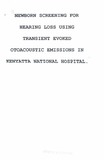| dc.contributor.author | Muhoho, N | |
| dc.date.accessioned | 2014-01-31T09:07:53Z | |
| dc.date.available | 2014-01-31T09:07:53Z | |
| dc.date.issued | 2004 | |
| dc.identifier.citation | Degree Of M.med (Ear Nose Throat Head And Neck Surgery), University Of Nairobi, 2004 | en_US |
| dc.identifier.uri | http://hdl.handle.net/11295/64443 | |
| dc.description.abstract | INTRODUCTION
Hearing loss is amongst the commonest congenital abnormality occurring in one to three newborns per thousand and has a profound effect on the development of
language and cognition in the affected child. The critical age for intervention has been identified as six months after which the child is disadvantaged in developing satisfactory communicative skills. Early detection of this problem has been difficult, although various screening test have been developed. Transient Evoked Otoacoustic emissions (TEOAEs), the test to be used in this study has been found to be a quick,
objective, non-invasive, accurate and easy test to perform.
BROAD OBJECTIVE:
Was to identify newborns with hearing loss and document results of hearing screening at KNH using TEOAE
SPECIFIC OBJECTIVES
1. To determine the usefulness of TEOAE as a screening
tool
2. To correlate results of hearing screening with TEOAE and presence of risk factors in newborns in KNH.
3. To determine the feasibility of a UNHS at the KNH
DESIGN OF STUDY
A cross sectional descriptive study.
METHODOLOGY
This was based on National UK Newborn Hearing Screening Pilot recommended test protocol, 26 November 2001.
RESULTS
291 Newborns were tested for hearing loss using TEOAE. 11 failed the screening. Risk factors for hearing loss were identified as low birth weight, prematurity, birth asphyxia, craniofacial anomalies, and bacterial meningitis. Ototoxic drugs were given universally making analysis impractical. Prolonged intubation newborns could not be tested due to technical limitations
CONCLUSIONS
Birth asphyxia as measured by a low APGAR scores is the most common risk factor to failure of TEOAE in our environment. Low birth weight and gestational immaturity
are also very significant. Ototoxic medications should be used with more rationale. | en_US |
| dc.language.iso | en | en_US |
| dc.publisher | University of Nairobi | en_US |
| dc.title | Newborn Screening For Hearing Loss Using Transient Evoked Otoacoustic Emissions In Kenyatta National Hospital. | en_US |
| dc.type | Thesis | en_US |
| dc.description.department | a
Department of Psychiatry, University of Nairobi, ; bDepartment of Mental Health, School of Medicine,
Moi University, Eldoret, Kenya | |

